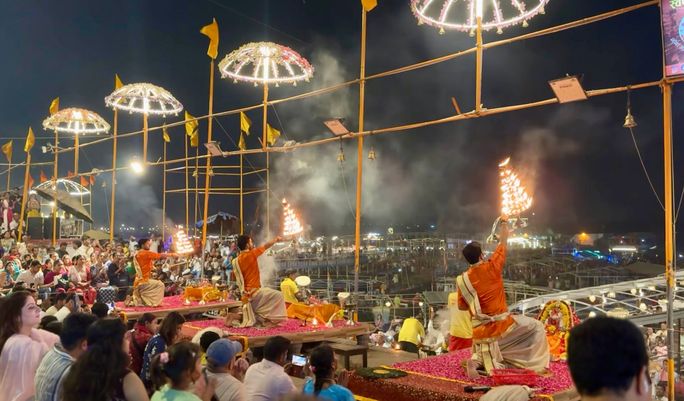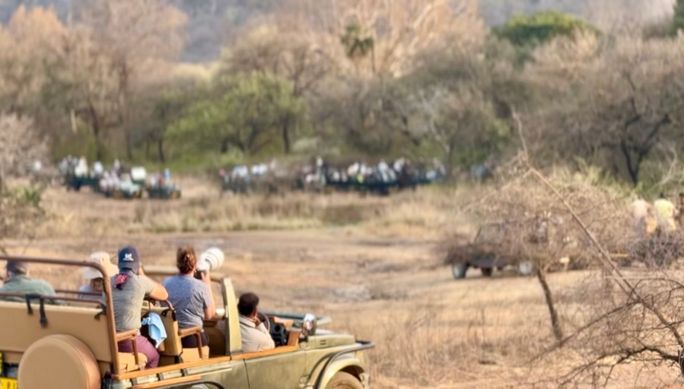
India’s Golden Triangle circuit is like essential
reading for first-time visitors to the subcontinent; the popular destination
track visiting New Delhi, Agra and Jaipur provides an introductory course to
the sights, sounds and tastes of the country, and within close enough distance
to one another that it’s easily navigable by private transfers or quick
flights.
In Old Delhi, you can sample local flavors on a guided
street food experience in the Chandni Chowk area, as well as visit UNESCO sites
like the Red Fort. In Jaipur, visiting the Pink City’s famous Hawa Mahal, or
“palace of the winds,” along with Amber Fort, are a must. And, of
course, Agra is home to the Taj Mahal, the 17th-century architectural marvel
and monument to love that is usually paired with a visit to Agra Fort, just
down the street.
But why should a first-time trip to India be limited to
the basics? Why not go the distance and add on other corners of the country to
explore what many might not see until their second or third return trip, to
places that truly stimulate the mind, body and soul?
That’s the kind of whirlwind adventure I had with Goway
Travel on a custom 10-day trip to India, which covered the Golden Triangle
circuit and also included stops in the Bengal tiger territory of Ranthambore
and the mystical city of Varanasi. Hardly a beginner’s journey, but certainly
by the end of it, emerges a seasoned traveler with tales to tell for ages.
The Myth & the Mysticism of Varanasi
In some ways, I’ve waited my whole life to visit
Varanasi. It’s one of the oldest cities in the world and is considered the
spiritual capital of India, a pilgrimage site for many Hindus, Buddhists, and
Jains. Located on the Ganges River, the city is renowned for its numerous
ghats, the steps on the riverbank that lead directly to the water, as well as
its temples and funerary ceremonies.
It was always a far-off land I grew up seeing in
National Geographic programs, a holy city where people chose to live out their
days, to be cremated and released from this earthly plane, their ashes spread
across the river, to reach an eternally enlightened kind of spiritual world. I
recall seeing people bathing in these sacred waters, the wailings of mourners,
and the prayer ceremonies that featured the vibrant colors of marigold and
bougainvillea flowers. What a place that must be, I used to think back then.
Fast forward 20-something years later, where I found
myself sitting in a small boat, traversing those very same waters, looking at
the ghats, crematoriums, and bathing pilgrims I had grown up watching on TV,
but now seeing with my own eyes.

Aarti, a prayer ceremony involving Hindu priests and candlelit altars, takes place every night at each of Varanasi’s famous ghats. (Photo Credit: Nicole Edenedo)
What I enjoyed most about visiting Varanasi with Goway
was that it felt like they had friends everywhere. Between sightseeing
excursions to Sarnath, an important Buddhist site, morning boat rides with
local musicians on the Ganges, and local dining experiences at Baath Chokha, we
would often pop in to say hello to other hotels, homestays, and cafes that the
company uses on its tours. While this was a press trip I was on and may not
necessarily happen on a regular tour, it was reassuring to see how deep Goway’s
resources and connections were in this bustling and crowded city, and how many
diverse options they can provide travelers who may be visiting with friends,
family, a partner or solo.
We stayed at the Taj Ganges, part of the luxury Taj
Hotels network, which was approximately a 20-minute drive from the old city.
Hotels outside the old city area are free to serve items like alcohol and
meat-based meals, making a place like the Taj Ganges ideal for those who prefer
these options. But for guests who don’t mind a vegetarian and alcohol-free stay
and want to wake up on the Ganges in the heart of town, the BrijRama Palace on
the banks of Darbhanga Ghat is a must. We toured the historic hotel after
dinner one evening, and its grand rooms, corridors, and live music performances
truly lived up to its palatial origins.
There were also early mornings spent winding through
the city’s alleyways before the crowds set in, and picking up clay cups of
masala chai on the go from street carts, or making time for a sip on a rooftop
cafe.
But chief among the most memorable things to do in
Varanasi is visiting the nightly Aarti ceremony along the main ghats in the old
city. Aarti is a prayer ritual performed by Hindu monks and priests who sing
hymns and wave lamps lit with candles before flower-adorned altars of Hindu
deities. It’s a ceremony of lights, and every evening at around 6:30 pm,
thousands of people, including Hindu pilgrims, gather on the steps of these
ghats to watch the roughly 90-minute ceremony. It truly is a moving sight to witness
and a spiritual space to be a part of.

Visitors to Ranthambore National Park spot Bengal tigers at the famous conservation grounds. (Photo Credit: Nicole Edenedo)
The Way of the Tiger
Of the few places in the world where tigers can be seen
in the wild, India is undoubtedly one of the best. The country is home not only
to one of the largest populations of tigers, but it also has several national
parks dedicated to their protection and conservation.
After two nights in Jaipur, we traveled a few hours
south by private sprinter van to Ranthambore, where we embarked on a two-day
tiger safari and wildlife experience at Ranthambore National Park. We stayed at
the Sawai Madhopur Lodge, a luxury historic property where the late Queen
Elizabeth and Prince Philip used to stay during hunting trips.
During our stay in Ranthambore, we made two visits, one
early morning and one late afternoon, which allowed us to see the tigers at
their most active times: dusk and dawn, as well as other wildlife, including
wild boar, primates, and crocodiles.
Like any wildlife safari, animal sightings are never
guaranteed. On our morning visit to the park, we waited for hours to spot a
tiger and nearly gave up before finally spotting Shakti, a female tiger who is
the mother of a few cubs at the park. She appeared almost out of nowhere
through the bush, passing calmly and majestically past our 4×4 jeep. Later,
when we returned to the park in the late afternoon, we spotted a couple of her
grown cubs who mostly took refuge in the shade, napped and rolled on their backs
in the grass. For a moment, it was easy to forget these were tigers; all I
could see were big cats lounging about for the day, much like my own at home.
The great thing about a custom trip is being able to
play things by ear and fit in side quests that might be harder to do in a large
group with a set itinerary. Beyond the tigers and wildlife, the park is also
home to the Ranthambore Ganesh Temple, situated within the park’s eponymous
fort, and is a pilgrimage site for Hindus. We fit in a visit before heading off
to our final stop in Agra, and it was well worth it. It’s a bit of an uphill
trek to reach the temple, which features low-rise stairs and slightly elevated
ramps, but the scenic walk through the fort is spiritually stimulating.
For the latest travel news, updates and deals, subscribe to the daily TravelPulse newsletter.

